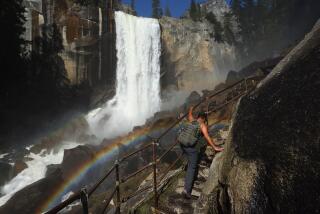Greater sage grouse
- Share via
[CENTROCERCUS UROPHASIANUS]
From the barren sagebrush flats of northeastern California to the upper end of the Owens Valley, an unearthly orchestra echoes in the deeply chilled dusk of a February morning. It’s the sound of dancing sage grouse, and this is their season to find mates. Scientists use the word “lekking” to describe the birds’ remarkable courtship in which dozens to hundreds of males gather at traditional sites and strut their stuff on well-worn arenas tramped down among the sagebrush. Swishing their wings to create a sound like rustling taffeta skirts and rapidly inflating their super-sized chest pouches to create loud gurgling pops reminiscent of whales burping underwater, male sage grouse fan their elegant tails and dance around with the stiffly self-conscious air of all cocky studs in the animal kingdom. Females gather each morning to watch the spectacle and pick the best dancers with which to mate.
NATURAL HISTORY
Sage grouse have not fared well due to destruction of their native sagebrush habitats and overhunting (the general season takes place one late-summer weekend). On their lekking grounds, they are so sensitive to disturbance that human viewers must arrive in the dark and remain seated in their cars until the morning display is over. Some sites are well-known and receive many visitors, but others are kept secret to give this troubled species some degree of protection.
KEY CHARACTERISTICS
The size of a large, elongated chicken, flecked with a brown mottled pattern that blends in among the sagebrush; during courtship, males show off yellow combs over their eyes and long plumes on their necks.
More to Read
Sign up for The Wild
We’ll help you find the best places to hike, bike and run, as well as the perfect silent spots for meditation and yoga.
You may occasionally receive promotional content from the Los Angeles Times.





